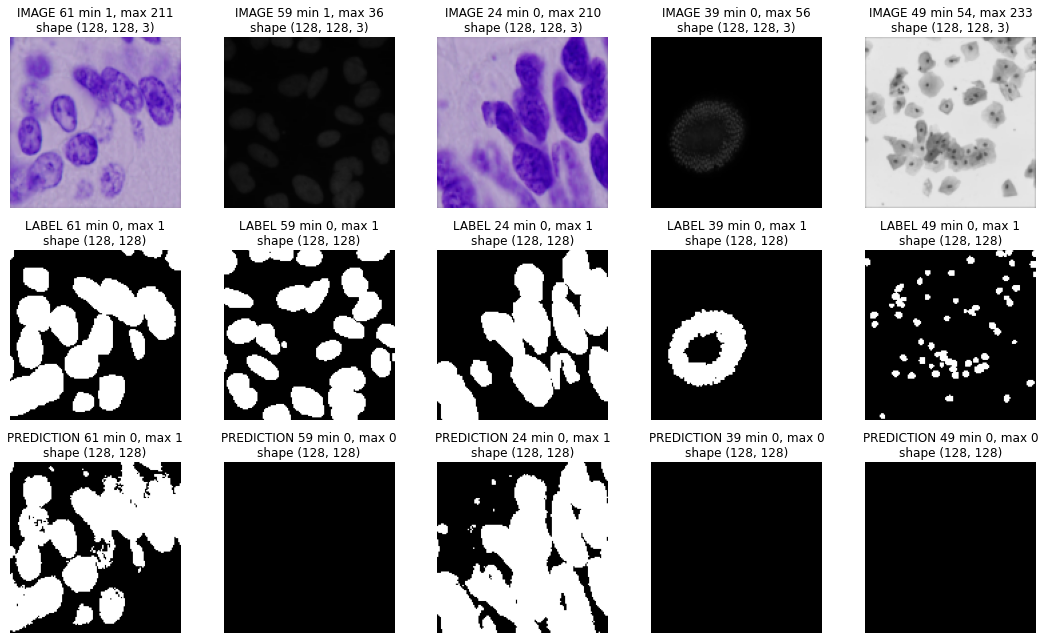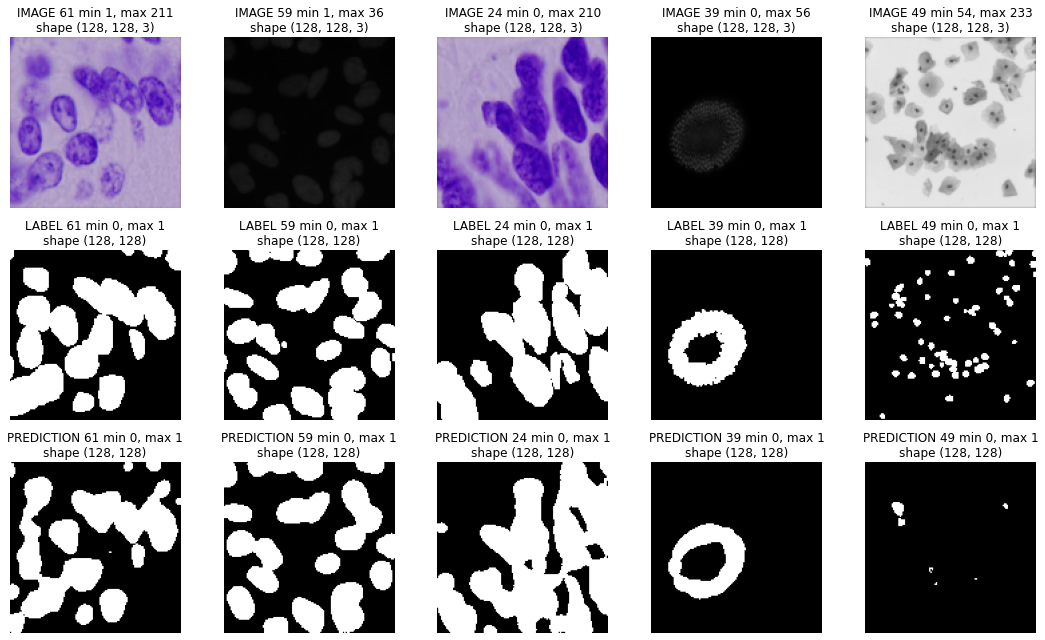LAB 4.4 - Semantic segmentation
Contents
LAB 4.4 - Semantic segmentation¶
!wget -nc --no-cache -O init.py -q https://raw.githubusercontent.com/rramosp/2021.deeplearning/main/content/init.py
import init; init.init(force_download=False);
from local.lib.rlxmoocapi import submit, session
session.LoginSequence(endpoint=init.endpoint, course_id=init.course_id, lab_id="L04.04", varname="student");
import pandas as pd
import matplotlib.pyplot as plt
from skimage import io
import numpy as np
import tensorflow as tf
%matplotlib inline
from IPython.display import Image
tf.__version__
TASK 1: Naive CNN for segmentation¶
Genera un modelo de segmentación semántica con la siguiente arquitectura:
Generate a semantic segmentation model with the following architecture:
The first two convolutional blocks from
UNet(c1/p1,c2/p2, with the sameDropoutandMaxPooling2D)A dense layer with 1000 neurons,
reluactivation, and aDropoutwith0.3A pre-output dense layer with
IMG_HEIGHT*IMG_HEIGHTneurons andsigmoidactivation.A
Reshapelayer as final output to sideIMG_HEIGHT, IMG_HEIGHT, 1
Using the initial Lambda layer, and with the Adam over rmse you should get exactly the following model configuration:
Model: "model"
_________________________________________________________________
Layer (type) Output Shape Param #
=================================================================
input_1 (InputLayer) [(None, 128, 128, 3)] 0
_________________________________________________________________
lambda (Lambda) (None, 128, 128, 3) 0
_________________________________________________________________
c1_conv1 (Conv2D) (None, 128, 128, 16) 448
_________________________________________________________________
c1_dropout (Dropout) (None, 128, 128, 16) 0
_________________________________________________________________
c1_conv2 (Conv2D) (None, 128, 128, 16) 2320
_________________________________________________________________
c1_maxpool (MaxPooling2D) (None, 64, 64, 16) 0
_________________________________________________________________
c2_conv1 (Conv2D) (None, 64, 64, 32) 4640
_________________________________________________________________
c2_dropout (Dropout) (None, 64, 64, 32) 0
_________________________________________________________________
c2_conv2 (Conv2D) (None, 64, 64, 32) 9248
_________________________________________________________________
c2_maxpool (MaxPooling2D) (None, 32, 32, 32) 0
_________________________________________________________________
flatten (Flatten) (None, 32768) 0
_________________________________________________________________
dense1000 (Dense) (None, 1000) 32769000
_________________________________________________________________
dense1000_dropout (Dropout) (None, 1000) 0
_________________________________________________________________
dense_128x128 (Dense) (None, 16384) 16400384
_________________________________________________________________
reshape_128x128x1 (Reshape) (None, 128, 128, 1) 0
=================================================================
Total params: 49,186,040
Trainable params: 49,186,040
Non-trainable params: 0
_________________________________________________________________
If you train your model with the Data Science Bowl segmentation images and labels at the corresponding UNet notebook in this course, you should get an output similar to the following one on these specific images on the VALIDATION set.
Image("local/imgs/unet-modelA.png", width=800)

def get_model_A(IMG_HEIGHT=128, IMG_WIDTH=128, IMG_CHANNELS=3):
from tensorflow.keras.layers import Dense, Input, Dropout, Lambda
from tensorflow.keras.layers import Conv2D, MaxPooling2D, Flatten, Reshape
from tensorflow.keras import Model
# Build U-Net model
inputs = Input((IMG_HEIGHT, IMG_WIDTH, IMG_CHANNELS))
s = Lambda(lambda x: x / 255) (inputs)
# YOUR CODE HERE
outputs = ... # YOUR CODE HERE
model = Model(inputs=[inputs], outputs=[outputs])
model.compile(optimizer='adam', loss='mse')
return model
inspect your model structure
m = get_model_A()
m.summary()
Registra tu solución en linea
student.submit_task(namespace=globals(), task_id='T1');
TASK 2: Naive CNN for segmentation with skipped connections¶
Add two layers at the end of the previous model so that the output is constructed by:
concatenating the input image channels to the output of the
Reshapelayerperforming a
1x1convolution on the previous concatenation
You should have a model such as
Model: "model_1"
__________________________________________________________________________________________________
Layer (type) Output Shape Param # Connected to
==================================================================================================
input_2 (InputLayer) [(None, 128, 128, 3) 0
__________________________________________________________________________________________________
lambda_1 (Lambda) (None, 128, 128, 3) 0 input_2[0][0]
__________________________________________________________________________________________________
c1_conv1 (Conv2D) (None, 128, 128, 16) 448 lambda_1[0][0]
__________________________________________________________________________________________________
c1_dropout (Dropout) (None, 128, 128, 16) 0 c1_conv1[0][0]
__________________________________________________________________________________________________
c1_conv2 (Conv2D) (None, 128, 128, 16) 2320 c1_dropout[0][0]
__________________________________________________________________________________________________
c1_maxpool (MaxPooling2D) (None, 64, 64, 16) 0 c1_conv2[0][0]
__________________________________________________________________________________________________
c2_conv1 (Conv2D) (None, 64, 64, 32) 4640 c1_maxpool[0][0]
__________________________________________________________________________________________________
c2_dropout (Dropout) (None, 64, 64, 32) 0 c2_conv1[0][0]
__________________________________________________________________________________________________
c2_conv2 (Conv2D) (None, 64, 64, 32) 9248 c2_dropout[0][0]
__________________________________________________________________________________________________
c2_maxpool (MaxPooling2D) (None, 32, 32, 32) 0 c2_conv2[0][0]
__________________________________________________________________________________________________
flatten (Flatten) (None, 32768) 0 c2_maxpool[0][0]
__________________________________________________________________________________________________
dense1000 (Dense) (None, 1000) 32769000 flatten[0][0]
__________________________________________________________________________________________________
dense1000_dropout (Dropout) (None, 1000) 0 dense1000[0][0]
__________________________________________________________________________________________________
dense_128x128x3 (Dense) (None, 16384) 16400384 dense1000_dropout[0][0]
__________________________________________________________________________________________________
reshape_128x128x3 (Reshape) (None, 128, 128, 1) 0 dense_128x128x3[0][0]
__________________________________________________________________________________________________
concatenate (Concatenate) (None, 128, 128, 4) 0 reshape_128x128x3[0][0]
input_2[0][0]
__________________________________________________________________________________________________
conv_1x1 (Conv2D) (None, 128, 128, 1) 5 concatenate[0][0]
==================================================================================================
Total params: 49,186,045
Trainable params: 49,186,045
Non-trainable params: 0
__________________________________________________________________________________________________
If you train your model with the Data Science Bowl segmentation images and labels at the corresponding UNet notebook in this course, you should get an output similar to the following one on these specific images on the VALIDATION set.
Observe how the model cannot abstract shapes and basically does a color filter. The semantic information upsampled is weaker than the skipped connections.
You might get a different output, depending on which kind of source images your model focuses on (black, white or pink background)
Image("local/imgs/unet-modelB.png", width=800)

def get_model_B(IMG_HEIGHT=128, IMG_WIDTH=128, IMG_CHANNELS=3):
from tensorflow.keras.layers import Dense, Input, Dropout, Lambda, concatenate
from tensorflow.keras.layers import Conv2D, MaxPooling2D, Flatten, Reshape
from tensorflow.keras import Model
# Build U-Net model
inputs = Input((IMG_HEIGHT, IMG_WIDTH, IMG_CHANNELS))
s = Lambda(lambda x: x / 255) (inputs)
# YOUR CODE HERE
outputs = ... # YOUR CODE HERE
model = Model(inputs=[inputs], outputs=[outputs])
model.compile(optimizer='adam', loss='mse')
return model
inspect the structure of your model
m = get_model_B()
m.summary()
Registra tu solución en linea
student.submit_task(namespace=globals(), task_id='T2');
TASK 3: UNET no skipped connections¶
Create a UNET model just like in the corresponding notebook in this course, but WITHOUT the skipped connections.
Your model structure should be as follows
model = get_model_UNET_no_skipped()
model.summary()
Model: "model_6"
_________________________________________________________________
Layer (type) Output Shape Param #
=================================================================
input_7 (InputLayer) [(None, 128, 128, 3)] 0
_________________________________________________________________
lambda_6 (Lambda) (None, 128, 128, 3) 0
_________________________________________________________________
conv2d (Conv2D) (None, 128, 128, 16) 448
_________________________________________________________________
dropout (Dropout) (None, 128, 128, 16) 0
_________________________________________________________________
conv2d_1 (Conv2D) (None, 128, 128, 16) 2320
_________________________________________________________________
max_pooling2d (MaxPooling2D) (None, 64, 64, 16) 0
_________________________________________________________________
conv2d_2 (Conv2D) (None, 64, 64, 32) 4640
_________________________________________________________________
dropout_1 (Dropout) (None, 64, 64, 32) 0
_________________________________________________________________
conv2d_3 (Conv2D) (None, 64, 64, 32) 9248
_________________________________________________________________
max_pooling2d_1 (MaxPooling2 (None, 32, 32, 32) 0
_________________________________________________________________
conv2d_4 (Conv2D) (None, 32, 32, 64) 18496
_________________________________________________________________
dropout_2 (Dropout) (None, 32, 32, 64) 0
_________________________________________________________________
conv2d_5 (Conv2D) (None, 32, 32, 64) 36928
_________________________________________________________________
max_pooling2d_2 (MaxPooling2 (None, 16, 16, 64) 0
_________________________________________________________________
conv2d_6 (Conv2D) (None, 16, 16, 128) 73856
_________________________________________________________________
dropout_3 (Dropout) (None, 16, 16, 128) 0
_________________________________________________________________
conv2d_7 (Conv2D) (None, 16, 16, 128) 147584
_________________________________________________________________
max_pooling2d_3 (MaxPooling2 (None, 8, 8, 128) 0
_________________________________________________________________
conv2d_8 (Conv2D) (None, 8, 8, 256) 295168
_________________________________________________________________
dropout_4 (Dropout) (None, 8, 8, 256) 0
_________________________________________________________________
conv2d_9 (Conv2D) (None, 8, 8, 256) 590080
_________________________________________________________________
conv2d_transpose (Conv2DTran (None, 16, 16, 128) 131200
_________________________________________________________________
conv2d_10 (Conv2D) (None, 16, 16, 128) 147584
_________________________________________________________________
dropout_5 (Dropout) (None, 16, 16, 128) 0
_________________________________________________________________
conv2d_11 (Conv2D) (None, 16, 16, 128) 147584
_________________________________________________________________
conv2d_transpose_1 (Conv2DTr (None, 32, 32, 64) 32832
_________________________________________________________________
conv2d_12 (Conv2D) (None, 32, 32, 64) 36928
_________________________________________________________________
dropout_6 (Dropout) (None, 32, 32, 64) 0
_________________________________________________________________
conv2d_13 (Conv2D) (None, 32, 32, 64) 36928
_________________________________________________________________
conv2d_transpose_2 (Conv2DTr (None, 64, 64, 32) 8224
_________________________________________________________________
conv2d_14 (Conv2D) (None, 64, 64, 32) 9248
_________________________________________________________________
dropout_7 (Dropout) (None, 64, 64, 32) 0
_________________________________________________________________
conv2d_15 (Conv2D) (None, 64, 64, 32) 9248
_________________________________________________________________
conv2d_transpose_3 (Conv2DTr (None, 128, 128, 16) 2064
_________________________________________________________________
conv2d_16 (Conv2D) (None, 128, 128, 16) 2320
_________________________________________________________________
dropout_8 (Dropout) (None, 128, 128, 16) 0
_________________________________________________________________
conv2d_17 (Conv2D) (None, 128, 128, 16) 2320
_________________________________________________________________
conv2d_18 (Conv2D) (None, 128, 128, 1) 17
=================================================================
Total params: 1,745,265
Trainable params: 1,745,265
Non-trainable params: 0
_________________________________________________________________
If you train your model with the Data Science Bowl segmentation images and labels at the corresponding UNet notebook in this course, you should get an output similar to the following one on these specific images on the VALIDATION set.
Observe that the segmentations are generally OK, but luck the detail on the UNet model WITH skipped connections.
Image("local/imgs/unet-noskipped.png", width=800)

def get_model_UNET_no_skipped(IMG_HEIGHT=128, IMG_WIDTH=128, IMG_CHANNELS=3):
from tensorflow.keras.layers import Dense, Input, Dropout, Lambda, concatenate
from tensorflow.keras.layers import Conv2D, MaxPooling2D, Flatten, Reshape, Conv2DTranspose
from tensorflow.keras import Model
# Build U-Net model
inputs = Input((IMG_HEIGHT, IMG_WIDTH, IMG_CHANNELS))
s = Lambda(lambda x: x / 255) (inputs)
# YOUR CODE HERE
outputs = ... # YOUR CODE HERE
model = Model(inputs=[inputs], outputs=[outputs])
model.compile(optimizer='adam', loss='binary_crossentropy')
return model
inspect the structure of your model
m = get_model_UNET_no_skipped()
m.summary()
Registra tu solución en linea
student.submit_task(namespace=globals(), task_id='T3');

